
~~~~~~~~~~~~~~~~~~~~~~~~~~~~~~~~~~~~~~~~~~~
Live Earth Farm (Com)Post
20th Harvest Week, Season 12
August 13th - 19th, 2007
~~~~~~~~~~~~~~~~~~~~~~~~~~~~~~~~~~~~~~~~~~~
(click here for a pdf of the paper
version of this newsletter)
In this issue
--Greetings from Farmer Tom
--Purslane - the 'wild veggie'
--A note from Debbie about Winter Shares and our 2008 Season
--Pictures around the farm
--What's in the box this week
--Notes from Debbie's Kitchen
--Calendar
--Contact Information
" Variety is the soul of pleasure."
~ Aphra Behn (from the book 'Slow Food Companion')
Greetings from Farmer Tom
~~~~~~~~~~~~~~~~~~~~~~~~~~~~~~~~~~~~~~~~~~~~~~~~
Ever wondered what it would be like to work on a farm? Here is a typical day, in the heart of the summer season:
It is Monday, 6:30am; another day, another week of harvesting is upon us. The morning is foggy and damp, the plants are wet, covered with a heavy dew. Everyone is gathered next to the strawberry plot in our field on Casserly Road. The yellow strawberry boxes are still in the harvest carts, marking the spot in the field where we left off picking on Saturday. For over 20 weeks now (since the end of March), we have been continuously harvesting strawberries – almost daily. Strawberries are best picked in the morning, since the fruit cool down during the night and are easier to snap off the plant. It takes a skilled hand movement – a combined twist, pull and snapping motion – to prevent the green calyx from separating from the berry. Picking strawberries requires bending low to inspect each plant, moving patiently up and down the rows, with focused attention, so as to discern the right quality of each and every berry. In a little over an hour 40 to 50 flats are picked [a flat = 12 baskets]; this is the usual amount we need to pick daily in order not only to stay on top of the continually ripening berries, but also to keep a fresh inventory for our delivery needs: to a local bakery, to farmer's markets, and of course for our CSA shares (which receive the majority of the harvest).
By 8am the green bean plants are still too wet to be picked; the sun won't be burning off the fog for another couple of hours, so the group splits up: some will pick cherry tomatoes, the rest, mostly the women, will pick raspberries. There is an important and often unrecognized benefit of a small scale, highly diversified farming operation such as ours, and that is that the physical labor of fieldwork – although all hard work – is at least varied. In other words, different motions and body positions are required for harvesting different crops (or for performing other tasks such as weeding or sowing), and so by alternating between crops or tasks, the physical strain (on one’s back, in particular) is distributed throughout the day.
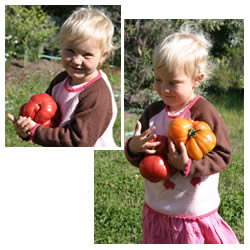
By 10 o' clock the sun is starting to burn off the fog; the harvest van is full, and the berries need to be transported from the field to the cooler. While Alejandro drives off to unload, the harvest switches to tomatoes. Our heirloom tomatoes are quite abundant right now; the fruit are maturing fast, and need to get picked off the plants. So this week’s shares boxes will be heavy, as we will be giving everyone between 3 and 4 of these wonderful summer fruit! (That's my daughter Elisa at right; the tomatoes are so big she can't even hold onto them all!)
By Noon nearly half a ton of tomatoes have been picked (i.e. fifty 20 lb. boxes), and it's time for a half-hour lunch break under the shady Mimosa trees alongside the field. The rhythm shifts after lunch: Clemente and Jonathan are off to irrigate a block of lettuce seedlings planted on Saturday as well as a block of freshly sown spinach, arugula, and radishes. (These three crops, incidentally, are typically sown together in one block, because they all germinate and mature within the same timeframe and generally have similar growing needs.) The rest of the group is off to pick green beans, as we'll need approximately 1000 lbs. (50 crates) over the next two days.
Now it’s around 4:30pm, and the last harvest of the day is the broccolini, which we like to harvest before it gets watered. The plants are waist high, and one gets completely drenched and muddy if we don't do the harvesting and watering in the right order. The broccolini is now tall, so all the shoots are within easy reach; no need to bend over. This Italian heirloom form of broccoli produces a large number of tender side shoots, and can be harvested multiple times over a period of up to 2 or 3 months. The last two years we have increased our plantings of broccolini, because not only does it have a superior taste but also it requires less space and is easier to harvest.
It is almost 6 o'clock now, and for everyone it's time to go home. Well... nearly everyone; two people continue to work: Juanillo is still plowing a field at our site along Pioneer Rd., and Juan is sowing green beans. These two will work until sundown, because it's a good time of day to work the soil – the day has cooled back down, and the soil moisture is 1 to 2 inches below the surface... ideal for sowing beans.
- Tom
<back to top>
Purslane - the 'wild veggie'
~~~~~~~~~~~~~~~~~~~~~~~~~~~~~~~~~~~~~~~~~~~~~~~~
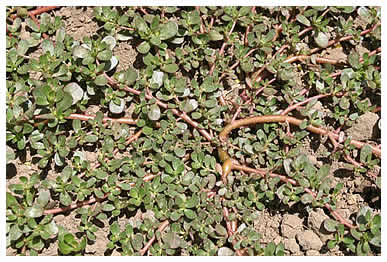 Purslane is now abundant in our fields, and since many of you have been asking
when we’re going to have it again, I’m going to put it into your
shares this week. It’s not a crop we sow, but definitely one we harvest!
You might even have in your backyard without knowing about its rich culinary
tradition.
Purslane is now abundant in our fields, and since many of you have been asking
when we’re going to have it again, I’m going to put it into your
shares this week. It’s not a crop we sow, but definitely one we harvest!
You might even have in your backyard without knowing about its rich culinary
tradition.
The USDA lists purslane as a pervasive weed (the 7th worst worldwide) but to
many of us who love its earthy, slightly acidic flavor and crisp, succulent stems
and leaves, the word "weed" hardly seems fair. Most of the time we
call plants weeds because they appear uninvited; here on the farm I try to coexist
with instead of fight them, and right now we have a beautiful crop of purslane
growing together with a maturing crop of green beans. Although purslane is rarely
seen as a cooking vegetable here in the United States, it actually has a long
and interesting culinary history elsewhere in the world. English medieval cooks
and gardeners loved purslane, and the ancient Greeks made flour from purslane
seeds and pickled its fleshy stems.
Today it's often served fresh in salads, either alone or with other salad greens.
Sure enough, a few weeks back we took Debbie and her husband Ken out to a long-promised
dinner at Chez Panisse in Berkeley – Alice Waters’ restaurant, famous
for sourcing all its food locally and organically – and lo and behold,
there were tender little purslane sprigs scattered atop the sautéed seasonal
vegetables. Debbie recognized them immediately. Juan tells me that in his hometown
in the State of Guanajuato, Mexico, they like to cook purslane (or verdolagas
in Spanish) with chili peppers, eggs and pork. And in China its sharp flavor
and slightly slippery quality is valued in combination with noodle dishes. I
like to chop clusters of young fresh leaves and combine them with other "sweeter" vegetables
such as potatoes, cucumbers, beets, and tomatoes. It can also be added to fish,
grills and omelets by simply sprinkling the purslane leaves with coarse salt,
lemon juice and olive oil.
Recent research has confirmed that purslane is one of the best vegetable sources
of omega-3 fatty acids, as well as carotene and vitamin C, and historically purslane
was described as a blood cleansing remedy for heart and liver problems. Enjoy
this ‘wild veggie’ – don’t be shy to try it! Your kids
may find adventure not only by searching for it in their own garden, but also
through eating something typically considered by others to be a weed. Now they
know better!
<back to top>
A note from Debbie about Winter Shares and our
2008 Season
~~~~~~~~~~~~~~~~~~~~~~~~~~~~~~~~~~~~~~~~~~~~~~~~
Increasingly I am being asked “When can I sign up for next year?” and “When
can I sign up for the Winter Share?” So... rather than answer those questions
multiple times a week on an individual basis, I am hoping to save myself some
time by answering them right here, in the newsletter.
Why can't I sign up now? I know I want a share next year, I'll send in
a deposit...
Right
now we are in the middle of significantly revising our member database. This
trusty tool, which was first developed for us in 2001 (back when we had 200 members
and 13 pick-up locations), and which I have lovingly tweaked and modified to
accommodate all the various changes the CSA's gone through since then – things
like changing the length of the season, and having two sizes of share instead
of one, and adding options to the share (each with a slightly different season)
like extra fruit, eggs, and ‘strawberry bounty’ [for
a few years we had a flower option, and even a bread option!]... well, now that
we have over 600 members, 33 pick-up locations and 3 delivery routes a week,
and last year we added the Winter Share... our database is kind of at it’s
limit, to say the least (me too!).
But what does this have to do with signing up for next year?? I'm telling you
this because I'll need to get our new and improved database in place and tested
before taking any signups. Right now I am shooting for having everything organized
and ready to roll by mid-to-late September. Beginning of October at the latest.
How does sign up work?
Members who have been with us more than one season already know that you need
to re-sign up each year, i.e. being a member one season does not automatically
guarantee your membership for the next. It does, however, have its privileges:
existing members get first crack at signing up for the share
combination of their choice during ‘Early Registration.’ After
a few weeks of ‘member-only’ sign-up,
we then open up early registration to people on our waiting list (which as of
this writing is closing in on 100 names). Finally after that, if shares are still
available, we will then open registration up to the general public.
What about the Winter Share?
To simplify things somewhat, we will be combining the Winter Share signup with
Early Registration, so that those who know they want to sign up for both can
do so in one transaction rather than two.
I won’t say more about the Winter Share now; when the time draws near,
Tom will talk about it in the newsletter in greater detail.
So how will I know when I can sign up?
Please wait until you are notified by email, which will be as soon as I (and
my new database) are ready to receive sign-ups. Again: existing members will
be notified first; wait-listers will be notified a few weeks later. Look for
a subject line of something like “Live
Earth Farm: Early Registration 2008 (and Winter Share signup)” All the
instructions will be in the email.
Anything else?
YES. Make sure I have your current email address. If you ever change your email
address, be sure to let me know at the farm,
as email is how I will be notifying everyone about Early Registration when the
time comes. If you use more than one email address, make sure I have the one
you want me to use for farm-related notifications. [We absolutely do not sell
or otherwise share our membership email list with anyone; it is purely for CSA
business.] And if you have any spam filters, be sure to set them to ‘always
accept email from’ farmers@cruzio.com
(our email address). Alternatively, if it is possible to set preferences by subject
line, remember that I always include the words ‘Live
Earth Farm’ in the subject line. You can always
search for that text string if you get a lot of junk email you have to wade through
but want to find email from me quickly.
<back to top>
Pictures around the farm
~~~~~~~~~~~~~~~~~~~~~~~~~~~~~~~~~~~~~~~~~~~~~~~~
The pear harvest Tom talked about in last week's newsletter is well
underway. We've picked 15,000 pounds of pears so far, and there are
still more to go! Here are pictures of the process. First, of course,
they must be picked: that's Clemente in the tree playing Tarzan ["Hombre
Mono" in Spanish], and Reynaldo on the ladder.
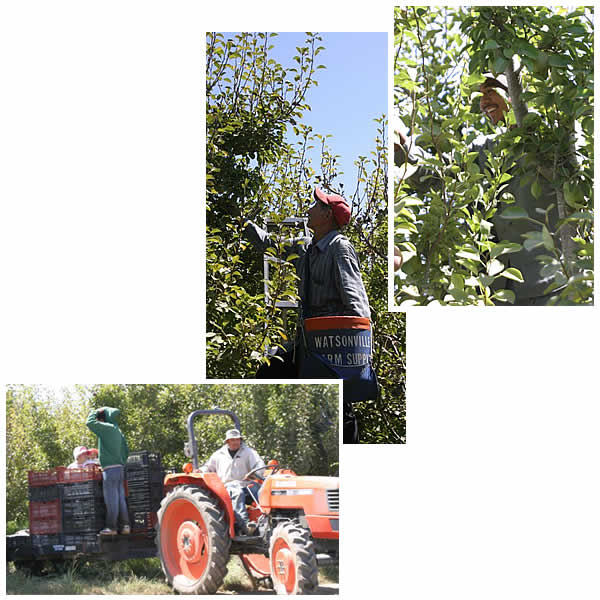
Juanillo drives the
tractor pulling a low trailer slowly through the rows of trees. The
pears are sorted by size right on the trailer, and then carefully layered
between foam pads so that they don't bruise as they ripen. That's Lisette,
at right, smiling over the top of a crate; below her are Angeles (left)
and Juana (right).
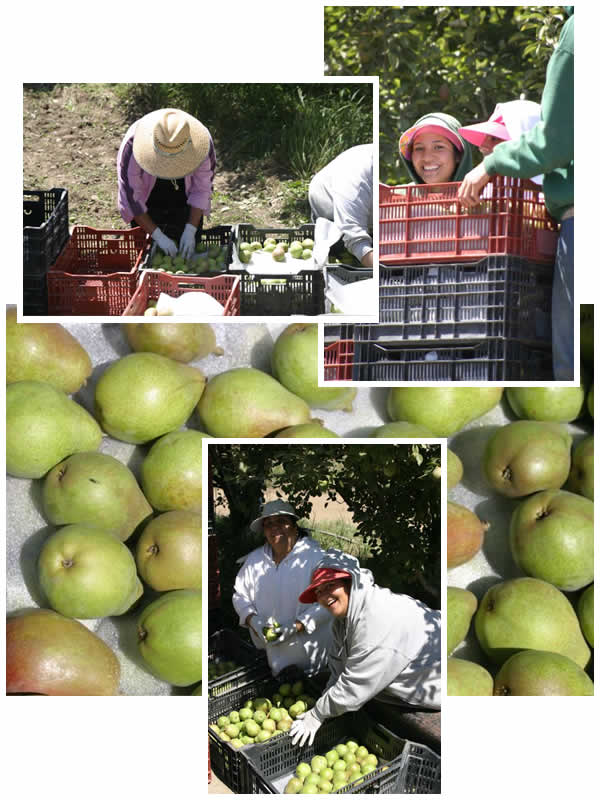
Finally the trailer of sorted, crated pears are brought out of the orchard
and loaded onto the truck. They will be taken to a big cooler where they will
be stored until we are ready to start putting them in your shares. That's
Juanillo in the floppy hat, and Clemente again, loading pears into the
truck.
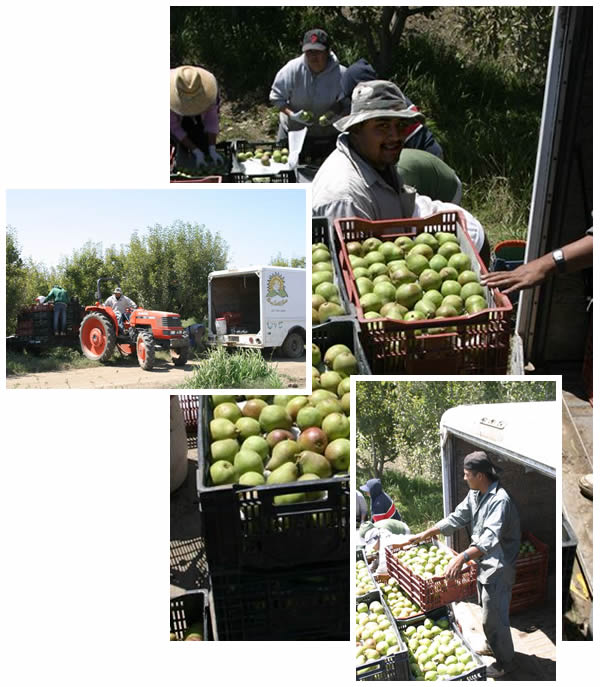
<back to top>
What's in the box this week
~~~~~~~~~~~~~~~~~~~~~~~~~~~~~~~~~~~~~~~~~~~~~~~~
Content differences between Family and Small
Shares are underlined and italicized; items with a “+” in
Family Shares are more in quantity than in Small; anticipated quantities are
in parentheses. Occasionally the content of your share will differ from what's
on this list, but we do our best to give you an accurate projection.
Family Share:
Arugula +
Beets (golden) [loose, no tops]
Broccolini
Eggplant +
Green beans +
Lettuce (romaine and red butter) +
Peppers + (mix of poblano, yellow wax and/or green bell)
Purslane
French breakfast radishes
Spinach
Heirloom tomatoes (3-4)
Dry-farmed tomatoes +
Cherry tomatoes
Strawberries (1 bskt)
(and possibly a basket of blackberries too! See checklist next to your name.
This will be a last-minute addition)
Small Share:
Arugula
Beets (golden) [loose, no tops]
Eggplant
Green beans
Lettuce (romaine and red butter)
Peppers (mix of poblano, yellow wax and/or green bell)
Purslane
French breakfast radishes
Heirloom tomatoes (3-4)
Dry-farmed tomatoes
Cherry tomatoes
Strawberries (1 bskt)
Extra Fruit Option:
Weds: Strawberries (2 bskts), Blackberries (2 bskts), Raspberries (1 bskt)
Thurs: Strawberries (2 bskts), Blackberries (1 bskt), Raspberries (1
bskt),
and a mystery (could be peaches, plums, new pink pearl apples...)
"Strawberry Bounty" Option:
-- stopped for now; will resume with next strawberry flush! --
<back to top>
Notes from Debbie's Kitchen
~~~~~~~~~~~~~~~~~~~~~~~~~~~~~~~~~~~~~~~~~~~~~~~~
Click
here to go to my extensive
recipe database, spanning 10 years of CSA recipes and alphabetized
by key ingredient. Includes photos of most farm veggies; helpful for
ID-ing things in your box! Also, FYI, as a rule, I put my own comments
within recipes that are not my own inside square brackets [like this]
to distinguish them from the voice of the recipe-writer.
This week, member Amoreena Lucero shares her ideas for what to do with
the box. Since she doesn’t eat the purslane, I’ll add some
recipes at the end here. I've highlighted this week's veggies in the
recipes in red. - Debbie
What I’d do with this week’s box
by Amoreena Lucero
My favorite season is late summer, when sweet peppers, eggplants and summer squash
are abundant and tomatoes are in their glory. A few seasons ago, we were
getting tons of eggplant, along with my other summer favorites. Looking
for a way to use all of these veggies, and stay out of my hot kitchen, I came
up with this recipe:
Grilled Vegetable Sandwiches with grilled Eggplant, Peppers, and Heirloom
tomatoes
(I'm not going to give you exact quantities because you can vary this
recipe for any number of people)
Other ingredients you'll need:
Minced garlic
Olive oil
Balsamic vinegar
Ciabatta (or baguette/foccaccia)
Chevre (either herbed or plain; Trader Joe’s has a good selection)
Red onions, sliced
Fresh basil leaves (optional)
Salt and pepper
Begin by mixing olive oil and minced garlic in a large bowl or baking
dish (no salt!). Make it as garlicky as you wish! Slice the
eggplant into thick (about 1/2 inch) slices, either horizontally or vertically
depending on the variety. Seed and then either quarter or halve
the peppers, and if you have and/or wish, slice summer squash vertically
into 1/2 inch slices. Brush
the eggplant with the garlic/olive oil mixture and set aside. You can toss
the peppers and squash with the remaining oil. Allow everything to marinate for
30 minutes. In the meantime, thickly slice your tomatoes and red onions
and set aside. Mix some balsamic vinegar with a little bit of olive oil, salt
and pepper in a small bowl and set aside. When your barbecue is hot, sprinkle
the eggplant & peppers with salt and pepper, then grill them for 3-4 minutes
per side, until well grilled and soft. [I’d maybe grill the onion slices
too? Either way’d be good. Mmmm... – Debbie] While your veggies
are cooking, slice your bread vertically into the sandwich sized pieces (if needed)
and then each piece lengthwise in half. Brush each half with the remaining
olive oil and garlic mixture from the veggies, adding olive oil as needed. Grill
the bread, olive oil side down, until golden and crunchy. To assemble sandwiches,
spread chevre on one side of the bread, lay some optional basil leaves on the
chevre, then layer with eggplant, peppers, onions and tomatoes. Drizzle the tomatoes
with the balsamic vinegar. Top
with the second slice of bread, and press down gently. This sandwich takes
two hands!
I usually serve this sandwich with a light salad of lettuce, radishes and tomatoes (and
maybe beets).
Deconstructed Arugula salad with Roasted Beets,
Chevre & Lemon vinaigrette
Another favorite combination is arriving in this week's box: arugula and
beets. Because I know I'll have chevre left over from the sandwiches, I'll
make a "deconstructed" salad of arugula lightly dressed with a lemon
vinaigrette (1:2 ratio of lemon juice & olive oil, plus salt and pepper),
roasted beets and a wedge of chevre. I plate the salad at the last minute,
placing a mound of dressed arugula, with beet wedges and a round of chevre on
each plate. The tangy/spicy flavors of the salad counter nicely with the
sweet, earthy flavor of the beets and the creamy taste of the chevre.
Green Bean & Cherry tomato Salad
Green beans - trimmed and blanched for 3 minutes in salted boiling water,
then given an ice water bath, well drained
Cherry tomatoes - halved
Red wine vinegar
EV Olive oil [that’s Extra Virgin, if you were wondering]
salt and pepper
Mix a 1:2 ratio (or to taste) of vinegar and olive oil in a large bowl with salt
and pepper. Toss the green beans and tomatoes into this mixture and allow
to marinate for 20-30 minutes before serving.
Pommodoro Sauce with Kalamata olives and Fresh Mozzarella
If we get a lot of tomatoes, this is what I usually do with them.
Garlic - minced or sliced (I like this recipe very garlicky)
Tomatoes - cut into chunks, about half of them seeded
or you'll have too much liquid
Fresh basil
Kalamata olives - pitted and halved
Fresh mozzarella - the boccaccini are the best size, or cut a larger one into
bite-size pieces
Penne pasta
EV Olive oil
S&P
Blend about 2/3 of your tomatoes in a food processor until pureed, but still
a little chunky. Get pasta water started. When your pasta water is
almost to a boil, warm a skillet over medium heat with EV olive oil. When
the oil is hot, add the garlic and cook until golden, but not caramelized. Your
pasta should go in the water about now. Add tomato puree and tomato chunks
to pan and sprinkle with S&P. Cook for 5 minutes, until tomatoes are
hot and slightly cooked. Add the kalamata olives and fresh basil to the
sauce. Add salt if needed. Allow to simmer on the stove until the pasta
is 1-2 minutes shy of done, then add the fresh mozzarella to the sauce, drain
pasta in a colander and add to sauce for a final minute of cooking. Plate
quickly, and garnish with basil.
Broccolini - I usually serve this as a side
dish, either blanched and dressed with a little soy sauce, or sautéed in garlic & olive
oil.
Any remaining heirloom tomatoes I'll serve
sliced & sprinkled with
good salt & fresh ground pepper, or Capresse style with sliced fresh mozzarella
and basil, drizzled with EV olive oil and balsamic vinegar.
Lastly, for dessert...
Pavlova - with fresh berries
(I got this recipe from my [Amoreena’s] mother-in-law; she's from
the UK, and it came from an old 70s cookbook she no longer has)
Meringue:
4 large egg whites
1 C superfine sugar
1 tsp. white vinegar
1/2 tbsp. cornstarch
Topping:
1 C heavy whipping cream
1 1/2 tbsp. granulated white sugar (or to taste)
1/2 tsp. pure vanilla extract
a variety of fresh berries
Preheat oven to 250 degrees F and place rack in center of oven. Line a baking
sheet with parchment paper.
Beat the egg whites on medium-high speed until they hold soft peaks. Start adding
the sugar, a tablespoon at a time, and continue to beat until the meringue holds
very stiff peaks. (Test to see if the sugar is fully dissolved by rubbing a little
of the meringue between your thumb and index finger. The meringue should feel
smooth, not gritty. If it feels gritty the sugar has not fully dissolved so keep
beating until it feels smooth between your fingers). Sprinkle the vinegar and
cornstarch over the top of the meringue and fold in with a rubber spatula. Gently
spread the meringue in a circle on the parchment paper, smoothing the edges,
making sure the edges of the meringue are slightly higher than the center. (You
want a slight well in the center of the meringue to place the whipped cream and
fruit.)
Bake for 1 hour 15 minutes or until the outside is dry and takes on a very pale
cream color. Turn the oven off, leave the door slightly ajar, and let the meringue
cool completely in the oven. (The outside of the meringue will feel firm to the
touch, if gently pressed, but as it cools you will get a little cracking.)
Just before serving gently place the meringue onto a serving plate. Whip the
cream until soft peaks form. Sweeten with the sugar (I
usually just throw whatever amount of sugar I think looks right into the cream!!) and
vanilla and then mound the softly whipped cream into the center of the meringue.
Arrange the berries randomly, or in a decorative pattern, on top of the cream.
Serve immediately, as this dessert does not hold for more than a few hours.
Here’s a picture Amoreena found online of a pavlova, on joyofbaking.com
(looks scrumptious!):

What to know about cooking with purslane
[back to Debbie here]
First off, I'd like to encourage everyone to just taste it first, especially
if you've never tried it. Pinch off a tender sprig from the end of one
of the stems and pop it in your mouth; chew it. To me it is just a little
lemony (sometimes more than others) and nutty and crunchy. Ever eat sourgrass
when you were a kid? Purslane has a hint of that flavor.
When you go to use it, like anything else, you'll want to go through it
and remove any old or yellowed leaves, and cut off any root ends; rinse
off any dirt, of course. But other than that, you can use both the leaves
and stems. It doesn't keep real long; try to use it sooner rather than
later.
So, first thing to know is, you don't have to cook it. You can indeed
just eat it raw. I like to pinch off
the tender ends (and/or cut the stems, leaves attached, into bite-sized
pieces) and use them fresh in salads; just toss 'em in with whatever green
salad you're making! Or make it the salad green: chop it up, add a bunch
of halved cherry tomatoes, maybe some sliced radishes, then make a simple
lemon vinaigrette, toss together and serve! (It doesn't have to be lemon
vinaigrette, you could use just about any salad dressing you like.)
The second thing to know is, it cooks quickly. It's a succulent, and so
contains a lot of water; it can get mooshy if overcooked. If you're
doing a sauté, add it near the end, for the last minute or two.
If you're making something baked, like a hot dish, don't think it matters;
mooshy is good! Just chop it up and add it with everything else. It'd
be good in something baked that had cheese and tomatoes, and maybe a garlicky
bread crumb topping!
Don't forget, it's nutritious to boot, so enjoy every bite!
<back to top>
Calendar of Events
~~~~~~~~~~~~~~~~~~~~~~~~~~~~~~~~~~~~~~~~~~~~~~~~
(see calendar on website for more info)
<> Sat. Jun 23 Summer Solstice Celebration (click
here for a wonderful movie of this year's celebration!)
<>Friday Aug 10, 17, 24, 31, Sept 7 and 14 Mataganza
Garden Sanctuary Internship Program
<> Aug 24-26 Childrens Mini-Camp sold out!
<>
Sat. Oct 20 Fall Harvest Celebration
<> Farm Work Days: Last Friday of each month, starting in June
and running through October. Please contact the farm at least 2 weeks
ahead of time if you want to participate; we need a minimum of 5 people
to hold a work day. Actual dates are: June 29th, July 2th, August
31st, September 28th, and October 26th. See here for
details!
<back to top>
Contact Information
~~~~~~~~~~~~~~~~~~~~~~~~~~~
email Debbie at the farm: farmers@cruzio.com
email Debbie at home (with newsletter input or recipes): deb@writerguy.com
phone: 831.763.2448
web: http://www.liveearthfarm.net
~~~~~~~~~~~~~~~~~~~~~~~~~~~